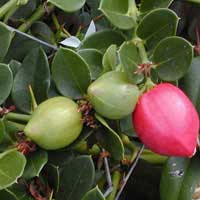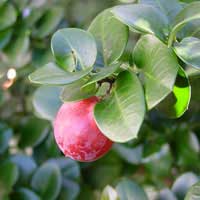 Full List of Fruits
Full List of Fruits  Sageretia fruit
Sageretia fruitSageretia fruit
![]() Introduction of Sageretia fruit
Introduction of Sageretia fruit
Scientific name - Sageretia theezans
The Sageretia fruit also known to be Mock Buckthorn consists of approximately 35 species, they fall under the shrub category of trees and are generally small in size too, these trees inherits from the Rhamnaceae family which originated from the south and eastern parts of the Asia and also the northeast part of Africa, the trees have leafs which are green in their color, the leaflets are of 1.5-4 cm length. The trunk is found to have a soft leather kind of texture containing many colors. The flowers are not attractive and are very small in their size; the fruit is also small in size falling under the drupe category of classification stretch to a diameter of 1 cm.
Their leaves acts as an excellent alternative of tea in the regions of China, the fruits are consumable ones but from commercial point of view they are not very supreme crop. In the southern part of China the most common species are known to be the S. theezans also there is a famous species in the northern part of China which is known to be the S. paucicostata. The species of S. paucicostata has the capability to withstand low temperatures, they are also domesticated sometimes in the orchids of Europe and also North America too. May be its flowers donít seem pleasant but are found captivate for growing them as ornamental plants.They have medical applications too, used in the first aid process by cleaning the small cuts of the skin and also severe injuries very widely and completely clears the traces of the germs thus prevents the infection caused by the germs.
The Sageretia trees must be planted in areas where there is proper sunlight but not cannot withstand very hot climatic conditions, they are grown out majorly in the night when the temperature falls up to a maximum of 5-6 degrees in the months mainly ranging from May to September in the regions of North Europe if they are planted indoors the Sageretia plants will survive only at variably humid regions and also the humidity/gravel tray must be partially left to cool in the night times, the room must not turn out to be very hot. The plants must not be kept in hot climatic conditions for a long time and does not withstand so much of cold too, the plant should not be kept in the outdoors mainly in the afternoon because it cannot be resisted by the plant as it is very hot mainly when it is beside glass to prevent blazing.
Feeding your Sageretia plant, you will need to provide it with the right nutrients to keep it healthy and thriving. Sageretia plants require regular fertilization to ensure optimal growth and health. It is important to use the right type of fertilizer for your plant and to apply it correctly.
For Sageretia plants, it is best to use a balanced fertilizer that contains equal amounts of nitrogen, phosphorus and potassium. This will ensure that your plant has all the nutrients it needs to thrive. It is also important to use a fertilizer that is specially formulated for acid-loving plants.
You should fertilize your Sageretia plant two to four times a year, depending on how quickly it is growing. When applying fertilizer, use a hose-end sprayer to avoid over-fertilizing the plant. Apply the fertilizer at the base of the plant, making sure to avoid contact with the leaves and flowers.
When you are fertilizing your Sageretia plant, it is also important to monitor your soil's pH level. Sageretia plants prefer soil with a pH between 5.5 and 6.5. If the pH is too low or too high, it can cause nutrient deficiencies and poor growth.
It is also important to provide your Sageretia plant with adequate water. They prefer moist, well-drained soil, and they should be watered regularly. Make sure to water the plant deeply and avoid over-watering as this can cause root rot and other problems.
Finally, it is important to prune your Sageretia plant regularly to maintain its shape and size. Prune back any branches that are growing too long or too thick and remove any dead or diseased branches. Pruning will also help to improve air circulation and decrease the risk of disease.
In conclusion, feeding your Sageretia plant is not difficult. All it takes is a balanced fertilizer, regular watering, and occasional pruning to keep it healthy and thriving. With proper care, your Sageretia plant can provide you with years of enjoyment.
 REPOTTING
REPOTTING
Repotting a Sageretia (or sweet plum) is an important part of keeping it healthy and thriving. In most cases, sageretias need to be repotted every two to three years. Repotting a sageretia can be a bit intimidating, but it is not as difficult as it may seem. With a few simple steps, you can successfully repot a sageretia and ensure that it continues to produce beautiful foliage and flowers
The first step in repotting a sageretia is to select a pot that is slightly larger than the current one. Sageretias prefer having their roots somewhat snug, so it is important not to choose a pot that is too large. Plastic or clay pots both work well. Once you have selected the right sized pot, add a layer of well-draining potting soil to the bottom.
Next, carefully remove the sageretia from its current pot. If the roots are bound up, use your fingers to gently loosen them. Once the plant is out of the pot, remove any dead or dying leaves and stems. Then, carefully inspect the root system. Remove any dead, broken, or damaged roots. If the roots are severely tangled, loosen them using your fingers.
After you have untangled and removed any dead roots, spread the root system out and place the sageretia in the new pot. Backfill with potting soil, filling in the gaps between the roots and the sides of the pot. Then, lightly press the soil down to firm it in place. Once the sageretia is firmly in place, water the soil thoroughly.
Finally, place the potted sageretia in a spot that receives plenty of indirect sunlight. Sageretias prefer bright but indirect light, so a room with a south-facing window is ideal.
Repotting a sageretia can seem intimidating, but it is relatively simple. All that is needed is a bit of patience and the right potting supplies. With a few simple steps, you can successfully repot a sageretia and ensure it continues to thrive.
The plant must be pruned out continuously in the season when it growth rates are higher , the back-budding takes place in the plant without much of efforts, the plants grow very thick thus can be pruned by using selective pruning, the wiring method need not be followed. The immature plants must be left to grow to a height of 10-15 cm prior to the process of pruning which makes the plantís trunk to become more firm. The plants which are fully grown having trunks which are very firm are pruned before itself.
 PROPOGATION
PROPOGATIONThe cuttings of the softwood and of the hardwood can be planted easily in the entire season of growth. The Sageretia plants cannot be found in the Garden Centers for selling purpose, they are only sold by the bonsai sellers mainly.


















